Introduction
Within This Page
The built environment is responsible for a large portion of global CO2 emissions that contribute to climate change. According to the International Energy Agency (IEA), the construction and operation of buildings accounts for approximately 35% of global energy consumption and 39% of emissions. The EPA reports that 42% of CO2 emissions have occurred in the last 30 years. Under the Paris Agreement the world came to consensus to limit global average temperature increase to "well below 2°C and to drive efforts to limit the temperature increase even further to 1.5°C above pre-industrial levels." This was further advanced at COP28 when twenty-eight countries, including the United States, committed to the vision that resilient buildings with near zero emissions will be the "new normal" by 2030. Zero Net Carbon (ZNC) buildings, also known as carbon neutral or zero carbon buildings, address the urgent need to mitigate the CO2 impacts of fossil fuel-based energy consumption.
The Biden administration took a number of actions to align with the goal, including outlining a federal definition for zero-emissions buildings that are highly energy-efficient, free of on-site emissions, and powered solely from clean energy. The Inflation Reduction Act, issued in 2022, is a commitment to build a new clean energy economy through incentives, grants, rebates, and other funding mechanisms. President Biden also issued Executive Order 14057, which is a broad sustainability plan for federal buildings and operations that includes "buy clean" provisions. Additionally, it includes the goal for all federal buildings to have net zero emissions by 2045 and a 50% emissions reduction from buildings by 2032.To achieve all these goals, the scientific community estimates that the world must reach zero fossil fuel emissions by the year 2050 and zero total global greenhouse gas (GHG) emissions between 2060 and 2080.
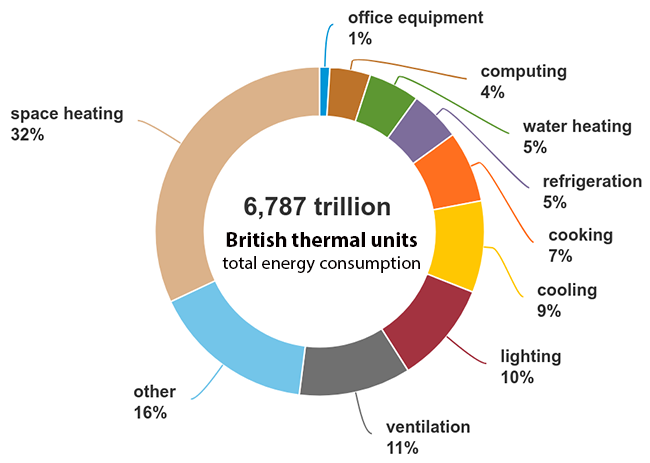
Major fuels consumption by end-use in commercial buildings. PSource: U.S. Energy Information Administration, Commercial Buildings Energy Consumption Survey, December 2022
The building sector has already begun to address these issues and to implement programs for both new and existing buildings. These programs are based on Zero Net CO2 emissions as a way to support and achieve the goal of keeping global temperatures below 2°C. How these buildings are defined, along with some of the issues to consider, are discussed in this page. Links to expanded resources and programs are provided for further exploration.
Description
A Zero Net Carbon (ZNC) building is defined as a highly energy efficient building that produces on-site, or procures, enough carbon-free renewable energy to meet building operations energy consumption on an annual basis. Sources of renewable energy include: solar energy from the sun, geothermal energy from heat in the Earth, wind energy, biomass from plants and other sources, and hydropower from flowing water. These sources of energy are naturally replenished.
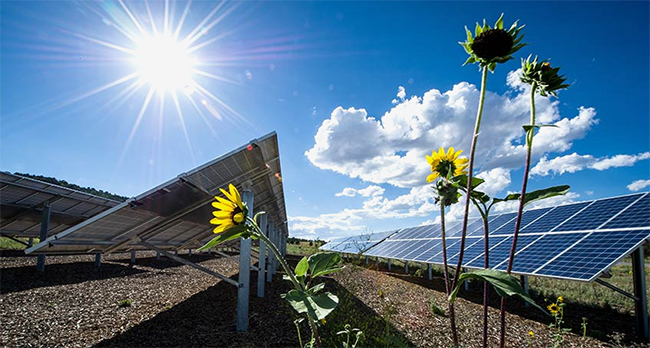
Field of photovoltaics converting energy from the sun into electricity. Photo Credit: National Renewable Energy Laboratory
All building types whether new or existing residential, commercial, institutional, and industrial buildings are included in this definition. The definition also applies to buildings in all types of settings, including those located in dense urban environments where on-site renewable energy production can sometimes be challenging or more limited. Additionally, it is important that entire installations, campuses, and portfolios of buildings be a part of the solution among companies, organizations, and agencies. These buildings must take into account a whole life-cycle assessment approach and must also be built with carbon neutral building materials and equipment. They are expected to be both sustainable and resilient. Resiliency is achieved by planning for and integrating specifications that are related to the future climate into the building design, construction, and operations and maintenance phases.
Application
Carbon-based energy consumption in a new Zero Net Carbon building is reduced first through building design strategies and efficiency measures, then through on-site renewable energy generation, and then finally through the procurement of locally produced off-site renewable energy sources.
A whole building design approach to net zero carbon will entail addressing the issues throughout all phases and the lifespan of a building including during construction, point of sale, when material and equipment are replaced or upgraded, and when there are zoning or building use changes. It also applies when there are upgrades to address life safety or resiliency issues such as seismic, flooding, fire prevention, power disruption, and more.
It is important to understand and address Scopes 1, 2, and 3 emissions in the planning and implementation process. Greenhouse gas emissions scopes organize and measure carbon emissions according to how they are created.
Scope 1: Carbon that is emitted directly from a company's building systems and vehicle fleets.
Scope 2: Carbon that is emitted indirectly through electricity or fuel consumption for heating and/or cooling buildings.
Scope 3: Carbon that is emitted indirectly, through the products and carbon produced from the extraction, manufacture, and processing of raw materials that are needed to manufacture products. This is the largest category, with 15 sub-categories and often where the largest impact is.
Measuring greenhouse gas emissions, or creating an emissions inventory, is critical to understanding the baseline of a company, organization, agency, or building's carbon footprint and impacts. To reduce emissions and fossil fuel use, it is important to calculate them before creating an emissions reduction target. Then a reduction target can be set using a variety of strategies. Once the target is set, then an action plan, regular progress checks, data gathering, and analysis will be required to remain on track.
Architecture 2030 suggests specific actions for new buildings and existing buildings, which focus on energy efficiency, electrification, and renewable energy. New buildings are to use no on-site fossil fuels and should be 100% powered by on-site and/or off-site renewable energy sources. They believe that every existing building will need to undergo energy upgrades to address this issue. This will include a combination of improvements in the energy efficiency of building operations, shifting to electric or district heating systems, which are powered by carbon-free renewable energy sources, plus the generation and/or procurement of carbon-free sources of renewable energy.
LEED Zero Carbon was launched by the U.S. Green Building Council under the Beta version of LEED v5 Operations and Maintenance: Existing Buildings. The prerequisite is that the project has first met LEED Gold Certification. Projects can achieve credit for no greenhouse gas emissions from onsite combustion with a few exceptions, and must achieve 100% renewable energy. Projects must also measure and report recharge of refrigerants for one year. For projects that include parking, one option is to achieve a minimum of 3 points for EV charging.
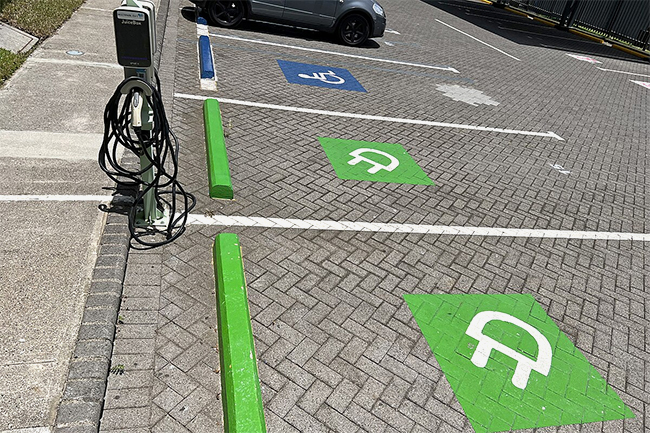
An electric vehicle charging station. Photo Credit: Wikimedia Commons/Mariordo
Zero Carbon Certification, a program of the International Living Future Institute, provides performance requirements specified for new and existing buildings, and reflect the following key principles. Projects must first reduce operational energy use and embodied carbon emissions associated with building materials and construction, while introducing no new combustion. 100% of the operational energy use associated with a project must be offset by new on- or off-site renewable energy. 100% of the embodied carbon emissions associated with the construction and materials of a project must be disclosed and offset.
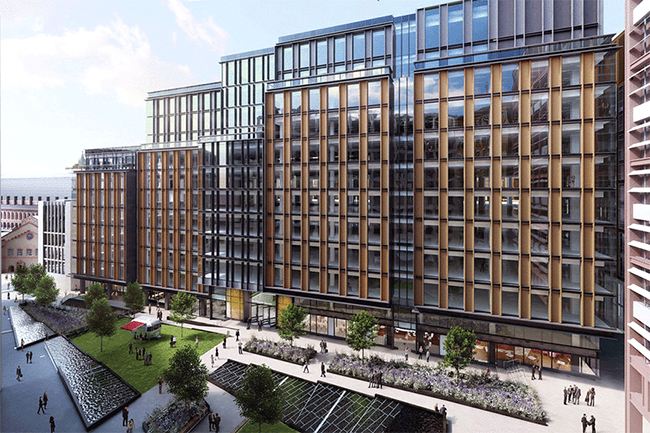
Lon 6 Pancras Square in London, England achieved Zero Carbon Certified under the International Living Future Institute's Zero Carbon program through a renovation of the existing building. Photo Credit: Tim Soars
Address Embodied Carbon
Embodied carbon, which is also known as embodied greenhouse gas (GHG) emissions, refers to the amount of GHG emissions associated with the extraction, production, transportation, manufacturing, installation, maintenance, repair or replacement, and eventual waste processing stages of a building product's life. Within the U.S. alone, billions of tons of concrete, asphalt, steel, glass, and other construction materials and products are required to construct, maintain, and operate the built environment, which encompasses roads, highways, bridges, buildings and houses, schools, and parks, and other infrastructure. Many initiatives to track, disclose, and reduce embodied carbon emissions also consider emissions associated with the use of a product and its disposal.
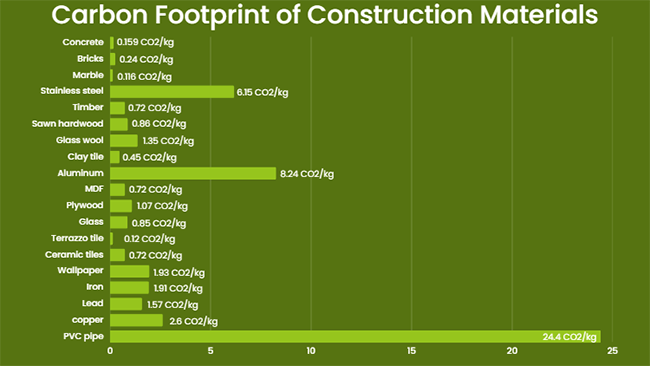
Carbon footprint of some building materials. Source: 8billiontrees.com
Solutions to address embodied carbon should include the following:
- Reuse: Renovating existing buildings, using recycled materials, and designing for reconstruction
- Reduce: Optimizing building materials and specifying low to zero carbon materials, and
- Sequester: Designing carbon sequestering project sites and using carbon sequestering materials.
The owners of Arthur Erickson Place, an iconic downtown Vancouver, Canada office building built in 1968, hope to earn zero-carbon certification from the Canada Green Building Council. This will be achieved with a retrofit that includes optimized HVAC controls, heat pumps, and new electric boilers. Photo Credit: Ryan Broda
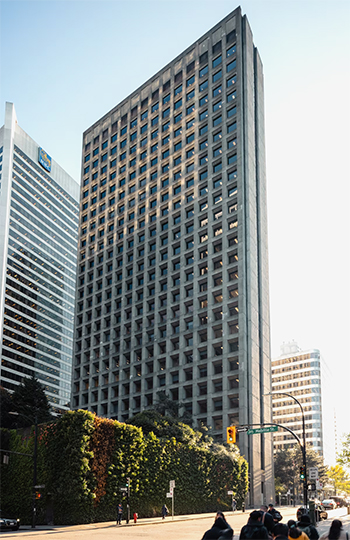
Address Operational Carbon
Operational Carbon is defined as the greenhouse gas emissions associated with the operational energy use of a building over its lifetime. In many cases, this could mean fifty years or more. Operational carbon currently accounts for 28% of global greenhouse gases. This includes all carbon from the energy required to heat and power the building, including lighting, plug loads, heating and cooling, cooking, and other activities in a building. It can also include other infrastructure such as lifts and automatic doors. By selecting materials, products, and systems that are durable, sustainable, and resilient, it is possible to reduce operational carbon in tandem with embodied carbon.
See Optimize Operational and Maintenance Practices and Sustainable O&M Practices
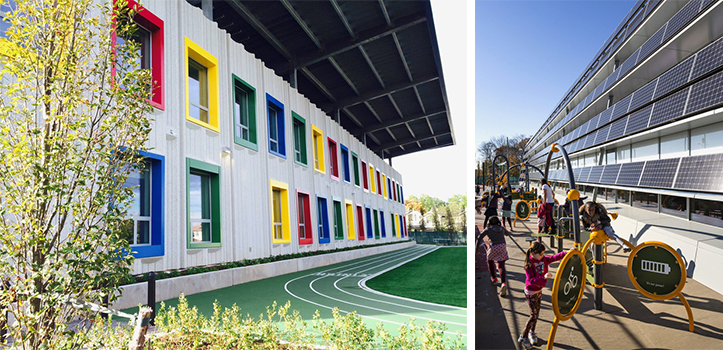
The Kathleen Grimm School for Leadership and Sustainability in Staten Island, New York has 1,997 solar panels that power the lights, computers, HVAC, and all other plug loads. Photo Credits: Kathleen Grimm School for Leadership and Sustainability
Steps to Achieve Zero Net Carbon
First, all building stakeholders need to be engaged in the process and throughout the entire life cycle to ensure cooperation and success. Adequate time should be given to the process in order to allow all perspectives, voices, and options to be explored for a fair, equitable, and transparent outcome. Set a vision for the project, team, and all stakeholders to demonstrate leadership and commitment to the goals. Investigate codes, standards, other building requirements, and funding, grant, and investment sources that may impact the process, budget, and timeline. Identify strategies that will meet the requirements and prioritize them in order to address the most effective and achievable goals first. Include the use of data and analytics to ensure that goals will be met over time.
Go beyond Zero Net Carbon and also address net-zero water and waste by completing deep retrofits and whole building commissioning; implementing space utilization and material use optimization; and deploying strategies that will maximize demand and flexibility through smart, grid-integrated controls, equipment, and devices. Reduce waste, minimize or eliminate the use of toxic and hazardous chemicals, and utilize recycled materials wherever possible. Identify and prioritize low/zero construction equipment, machinery, and project sites. Optimize logistics and transportation impacts before, during, and after construction. Plan, design, and construct with nature-based solutions including protecting natural resources and sensitive habitats, as well as establishing and preserving animal and plant corridors to ensure biodiversity and climate resiliency.
Relevant Codes, Standards, and Guidelines
- Declare Label, Program of the International Living Future Institute
- EDGE, A green building certification program of the World Bank Group
- Environmental Product Declaration (EPD), a transparent, objective report that communicates what a product is made of and how it impacts the environment
- Executive Order 14057: Catalyzing Clean Energy Industries and Jobs Through Federal Sustainability
- Federal Building Performance StandardDownload federal-building-performance-standard.pdf , Council on Environmental Quality, Executive Office of the President
- Federal Sustainability Plan, Net-Zero Emissions Buildings, Office of the Chief Sustainability Officer
- Guiding Principles for Sustainable Federal BuildingsDownload guiding_principles_for_sustainable_federal_buildings.pdf , Council on Environmental Quality
- Inflation Reduction Act, Low-embodied Carbon program
- LEED Zero Carbon, Program of the U.S. Green Building Council
- Zero Carbon Certification, Program of the International Living Future Institute
Additional Resources
Organizations
- AIA, Zero Carbon
- Architecture 2030
- ASHRAE Task Force for Building Decarbonization
- Carbon Leadership Forum
- International Living Future Institute
- International Institute for Sustainable Development
- New Buildings Institute
- National Renewable Energy Laboratory (NREL)
- Rocky Mountain Institute
- U.N. Environment Programme—Global Alliance for Buildings and Construction
- U.S. Green Building Council
Publications
- Breakthrough Agenda Report by the International Energy Agency (IEA), the International Renewable Energy Agency (IRENA), and the United Nations Climate Change High-Level Champions. 2023.
- Building a Clean Economy: A Guidebook to the Inflation Reduction Act's investments in Clean Energy and Climate ActionDownload Inflation-Reduction-Act-Guidebook.pdf by The White House and CleanEnergy.gov, January 2023.
- Building Materials and the Climate: Constructing a New Future by the U.N. Environment Programme. 2023.
- Buildings and the IRA: The New Incentives for Going GreenDownload USGBC-IRA-Green-Buildings_0.pdf by the U.S. Green Building Council, February 25, 2024.
- Driving Action on Embodied Carbon in BuildingsDownload driving_action_on_embodied_carbon_in_buildings_report.pdf by RMI and USGBC. 2023.
- Roadmap to Reaching Zero Embodied Carbon in Federal Building Projects by By Anish Tilak, Connor Usry, and Victor Olgyay. 2022.
- State of Decarbonization: Progress in U.S. Commercial Buildings 2023 by the U.S. Green Building Council and ARUP. 2023.
- Zero Code—Off-Site Procurement of Renewable EnergyDownload Zero-Code-TSD-OffSiteRenewables.pdf by Architecture 2030
- Zero Emission Building New Construction Guide Prepared by the New Buildings Institute for the City of Santa Monica, California. March 2023.










